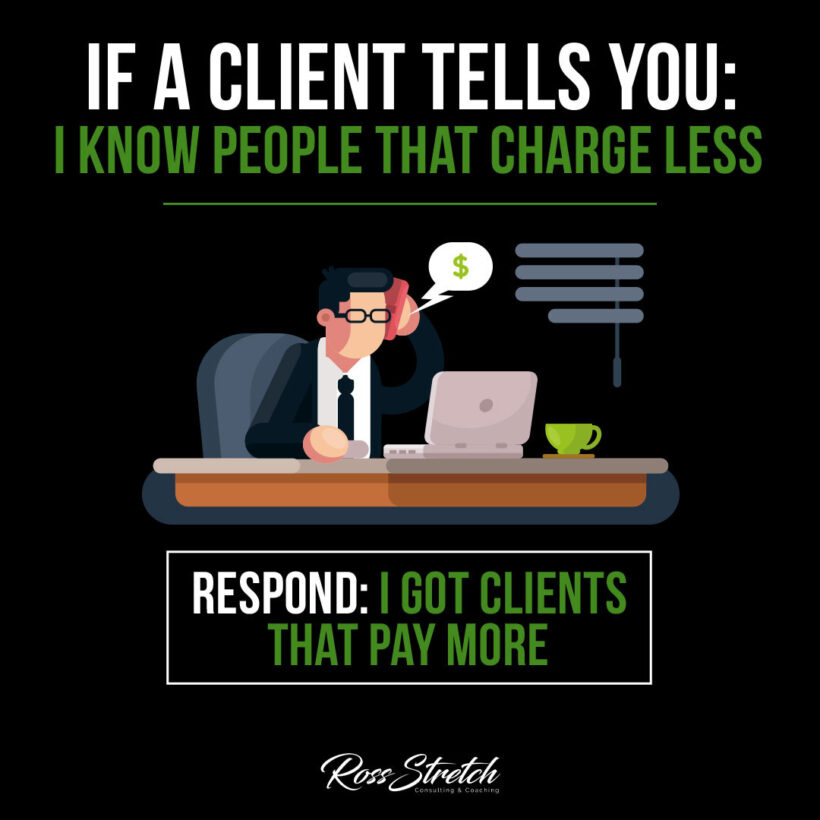As a freelancer or business owner, you’ve likely encountered clients who try to negotiate your rates by saying, “I know people that charge less.” This situation can be uncomfortable, but with the right approach, it can become an opportunity to reinforce your value. In this article, we’ll explore how to handle pricing objections confidently and professionally, ensuring you maintain your worth while building stronger client relationships.
1. Understand the Client’s Perspective
When a client mentions that they know people who charge less, they’re usually trying to save money. This is a common tactic and doesn’t necessarily reflect on the value they see in you—it’s more about their budget or negotiation style. Take a moment to understand their concerns and let them express their thoughts fully.
- Tips for Understanding the Client’s Needs:
- Ask Open-Ended Questions: Try asking, “Could you share more about your budget and expectations?” This opens up a conversation about their priorities.
- Listen Actively: Pay attention to what they say to gain insights into their concerns. For instance, they may be more price-sensitive than other clients, or they may not fully understand the value you provide.
Understanding the client’s perspective allows you to address their concerns effectively and tailor your response.
2. Emphasize the Value You Bring
When clients bring up the “cheaper option,” it’s essential to shift the conversation from price to value. Highlight the unique qualities you bring to the table—your experience, quality of work, and proven results. Explain that while cheaper options exist, they may not offer the same level of quality, reliability, or expertise.
- Ways to Communicate Your Value:
- Highlight Relevant Experience: Share examples of successful projects you’ve completed for similar clients.
- Discuss Quality Assurance: Explain the steps you take to ensure quality, such as thorough revisions, quality checks, or customized solutions.
- Showcase Testimonials: Share testimonials from clients who have benefited from your services, emphasizing the positive outcomes they achieved.
By focusing on value, you make it clear that working with you is an investment, not just a transaction.
3. Politely Assert Your Rates
It’s essential to stand firm on your rates and not devalue your work. Politely but assertively communicate that your rates reflect the quality, experience, and dedication you bring. A confident response, such as “I got clients that pay more,” as suggested in the infographic, shows that you’re in demand and that your pricing is justified.
- Example Responses:
- “I understand the importance of budgeting, but my rates reflect the quality and commitment I bring to every project.”
- “I’ve built my rates based on the value I provide, and I have clients who appreciate the impact of my work at this price.”
- “I’ve found that clients who value quality over cost have been extremely satisfied with my work.”
By stating your rates confidently, you position yourself as a professional who understands their worth.
4. Offer Alternative Solutions
If the client’s budget is a legitimate concern, consider offering alternative solutions that align with their financial situation without compromising your rates. This could include adjusting the scope of the project, offering a payment plan, or suggesting a phased approach.
- Suggestions for Alternative Solutions:
- Adjust the Scope: Offer a scaled-down version of your service that fits within their budget.
- Phased Project Approach: Suggest completing the project in phases, with each phase billed separately.
- Payment Plans: Provide a flexible payment plan to spread the cost over time, making it more manageable for the client.
Providing alternatives shows that you’re willing to work with the client without undercutting your rates.
5. Reframe the Conversation Around Long-Term Benefits
Help the client understand that investing in quality services often leads to better results, which can save them money in the long run. Explain that cheaper options may seem appealing but can come with hidden costs, like poor quality, revisions, or even needing to hire someone else to fix mistakes.
- Benefits of Investing in Quality Services:
- Reduced Revisions: High-quality work requires fewer revisions, saving time and money.
- Better Results: Quality services yield better outcomes, which translates to a higher return on investment.
- Peace of Mind: Working with a reliable professional provides peace of mind, knowing that the job will be done right the first time.
By reframing the conversation around long-term benefits, you help the client see the real value in choosing quality over cost.
6. Know When to Walk Away
Not every client will understand the value of your services, and that’s okay. Sometimes, the best decision is to walk away from clients who prioritize cost over quality. Working with clients who respect your rates and value your work leads to better relationships and more fulfilling projects.
- Tips for Knowing When to Walk Away:
- Identify Red Flags: If a client repeatedly tries to negotiate your rates or dismisses the value of your services, it may be a sign that they’re not a good fit.
- Trust Your Gut: If you feel that the client isn’t willing to appreciate your work, it’s better to part ways respectfully.
- Politely Decline: A polite response like, “I believe my services might not align with your current budget, but I’d be happy to work together in the future if circumstances change,” leaves the door open for potential collaboration later.
Choosing clients who respect your value and pricing leads to better, more productive partnerships.
Conclusion
Handling clients who say, “I know people that charge less,” requires confidence, professionalism, and a focus on value. By shifting the conversation to what you offer, asserting your rates, and providing alternative solutions, you can address pricing objections effectively. Remember, your rates are a reflection of the quality and expertise you bring to the table, and the right clients will appreciate and respect that.


